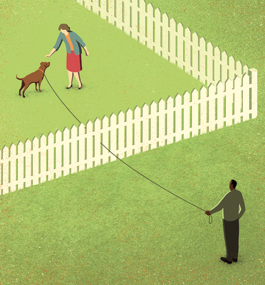Letters

Thy neighbor’s dog
In the feature “Diversity’s Fault Lines” (Fall 2021), which discussed sociologist Sarah Mayorga’s research on how white people interact with their Black and Latinx neighbors, I was struck by the example of how “Tammy” reacted to her neighbor’s barking dog.
Was it odd that Tammy was triggered by a barking dog? Was it really because she is white and her neighbor is not? And if my dog seems happy after a walk, is that a figment of my white anxiety? All this appears to be what Mayorga is suggesting.
Where the Tammy anecdote got remarkable — and weird — is when she uses binoculars to spy on her dog-owning neighbor before knocking on his door and having a conversation. If we want to talk about fragility, that’s the moment.
In all fairness, Mayorga gets to the nub of the issue in the end when she says, “Rather than asking, ‘What can I do about my neighbor’s dog?’ [Tammy] could have asked, ‘Why is this person a stranger to me?’” That’s a downright biblical question. And that’s the heart of the story. Racism is real. But perhaps it’s more realized in the surveillance of a neighbor than in dog-care norms.
Rev. Amy Crocker Beveridge ’98
Central Coast area, California
* * * * * *
I read with interest the article on Sarah Mayorga’s research. I would welcome an additional study of a diverse neighborhood where people do know their neighbors. What factors allow this to happen?
I found I disconnected from the article when I arrived at the section that discussed residents’ beliefs about how dogs should be treated. In trying to avoid judging others’ cultural norms, we can mistakenly decide that animal mistreatment is only a different cultural norm.
Another issue troubles me: trying to fit an entire group of people into one behavior pattern. Categories can be informative, I know, but I am so much happier living outside their confining restraints.
— Janet Fishman ’70
Adjunct professor in critical studies
The University of the Arts
Philadelphia
Communal viewing
I enjoyed Ulka Anjaria’s article on Bollywood films (“A Register of Feeling”) in the Fall issue’s Arts and Culture section. I was especially pleased to learn that students sometimes invite a big group of people to join them in watching the films she assigns for her classes. Back in my day, the only way to watch movies on campus was communally, often in the large auditorium in Ford Hall. Those showings evoked plenty of clapping, hooting and laughter. One classic movie line that never failed to get a loud response was in “Casablanca,” when Humphrey Bogart tells the Nazi officer, “There are certain sections of New York, Major, that I wouldn’t advise you to try to invade.”
— Michael Gerver ’70
Raanana, Israel
